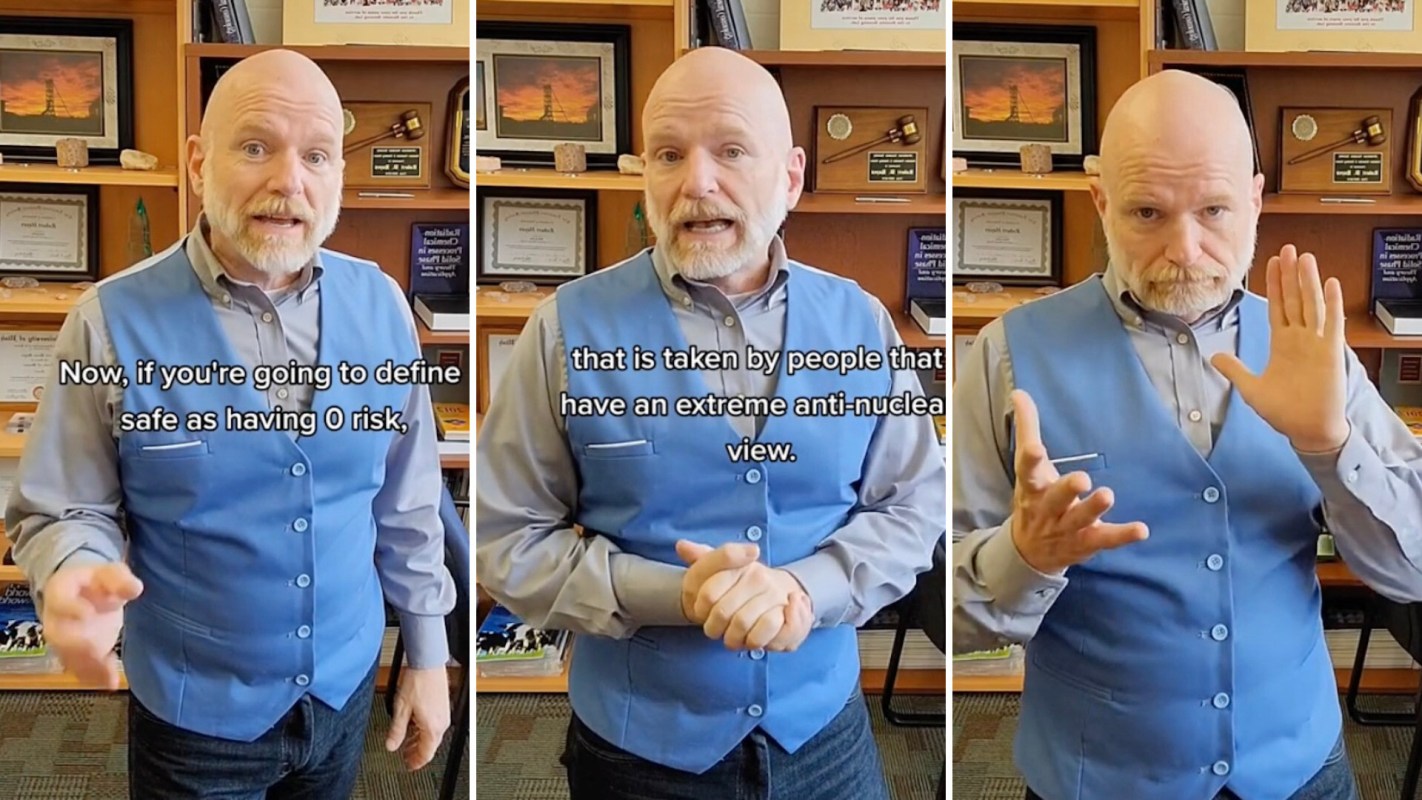Terms such as "nuclear power" and "radioactivity" can incite fear and distrust, but one professor is here to dispel any misguided perceptions surrounding the energy source.
Robert Hayes, an associate professor of nuclear engineering at North Carolina State University who posts as nuclearsciencelover (@nuclearsciencelover), made the case in a TikTok video that the anti-nuclear movement is rooted in ideology rather than observational metrics.
@nuclearsciencelover #stitch with @all_in_tok The science supporting this claim can be found in the open source review paper: Cleaner Energy Systems Vol 2, July 2022, 100009 Nuclear energy myths versus facts support it's expanded use - a review doi.org/10.1016/j.cles.2022.100009 #nuclear #antinuclear #stem #cleanenergy #sustainability #ghg #rhetoric #engineering #professor ♬ Blade Runner 2049 - Synthwave Goose
The video begins with a clip of independent presidential candidate Robert F. Kennedy Jr., who has remained skeptical of nuclear power, speaking about the Indian Point nuclear power plant in New York.
"I don't see how you can say it's safe," he said. "They still haven't figured out what to do with the waste."
While it's true many nuclear plants and decommissioning projects have faced criticism for leaking incidents and handling of wastewater, indicating the process is not perfect, Hayes refuted Kennedy's claim by challenging viewers to think about what safety entails and the lens through which we perceive what is dangerous and what is not.
🗣️ Would you be comfortable having a nuclear power plant in your town or city?
🔘 YES 👍
🔘 NO 👎
🗳️ Click your choice to see results and speak your mind
"If you're going to define 'safe' as having zero risk, then literally nothing is safe," Hayes rebutted. "Everything has some kind of risk."
However, as Hayes noted, if we consider the safety of nuclear power in terms of acceptable risk, it's "one of the safest forms of energy that's out there" in terms of historical deaths per gigawatt-hour of energy produced — even when factoring in the Chernobyl and Fukushima disasters and the 1979 major accident at Three-Mile Island (which resulted in no direct injuries or deaths, but studies have sought to explore whether the radiation emitted could be linked with any subsequent health effects).
Accordingly, if a nuclear power plant replaces multiple coal plants, there is a net reduction in health risks and expected deaths. This is further supported by a NASA brief that estimated "nuclear power prevented an average of over 1.8 million net deaths worldwide between 1971-2009." And in a hypothetical scenario in which you started with nuclear power, and coal were the new power source to consider, the risk for causing additional deaths might stand out even more. Hayes' point boils down to the idea that the risks associated with nuclear power should be compared to the risks of what the technology replaces, rather than considered in a vacuum.
Hayes' review from 2022, seeking to dispel myths and "present the facts about nuclear energy divorced from political, social, or comparable bias," found that the industrial sector — a small percentage of which is made up of nuclear power — accounts for less than 0.1% of all sources of radiation exposure to the average United States citizen.
Furthermore, Hayes cited the U.S. Nuclear Regulatory Commission when mentioning that there has never been an accident involving the transportation of a nuclear waste cask that has caused detectable levels of radioactivity.
"This work finds that nuclear energy is akin to a climate savior, given the overwhelming utility, low risk and sustainability available from this technology," Hayes wrote. "The US should seriously seek to drastically expand its replacement of fossil fuels with nuclear energy to address both climate change and energy security."
The comment section of the video mostly agreed with Hayes' message.
One commenter said they "agree that nuclear is safer than its rep" but that at least for short-term goals to get carbon pollution under control as soon as possible, spending the time and resources to build new nuclear power plants "shouldn't be a priority over other renewables & carbon capture otherwise it will be for [naught]."
Another agreed more wholeheartedly with the video's message: "Exactly. I have a relatively large chance of getting badly hurt every single time I drive to just get snacks. The 'risk' is worth it."
Meanwhile, in the even longer-term goals of cutting down on pollution from dirty energy through nuclear power, scientists are also growing increasingly optimistic they can harness another type of nuclear energy — fusion — with a facility in southern France working on "arguably the most complex machine ever designed."
Join our free newsletter for weekly updates on the coolest innovations improving our lives and saving our planet.









